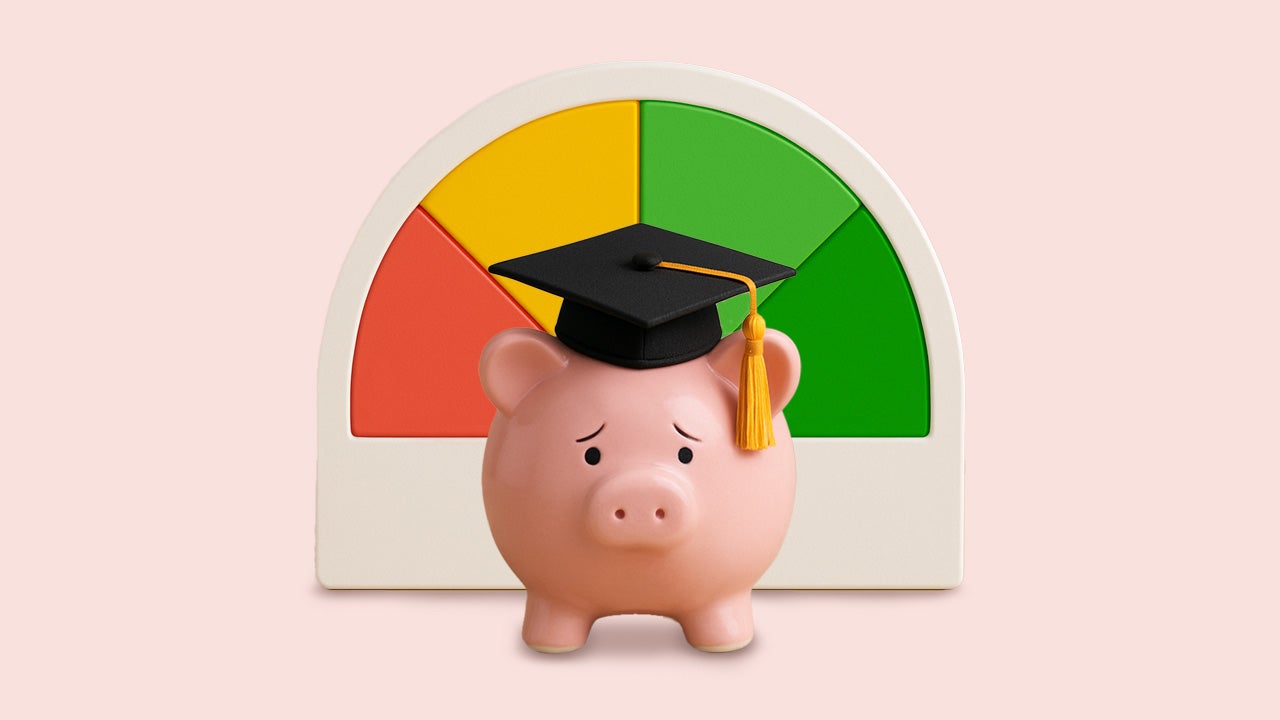Image by GettyImages; Illustration by Bankrate
Imagine your credit score suddenly dropping by 63 points.
For more than four million federal student loan borrowers, that’s no nightmare. It’s a wake-up call.
In fact, a 63-point drop was just the average. Many of these borrowers experiencing a serious delinquency — at least 90 days late on a payment — in early 2025 saw their credit score drop by 42 to 175 points, according to a May analysis by the credit bureau TransUnion.
And no one is immune. Borrowers with strong credit histories and cleaner credit reports saw their scores drop the most, by up to three figures.
Even scarier? These borrowers could soon have more company. Some of the nearly eight million enrolled in the decaying SAVE Plan may soon face delinquency. So too could borrowers who have been struggling to enroll in income-driven repayment (IDR) plans.
“We’re just waiting for them to be reported — we’re calling those the shadow delinquencies,” says Michele Raneri, TransUnion vice president of financial services research and consulting.
How we got here: The student loan delinquency crisis
Yes, more than one in every five federal student loan borrowers in active repayment — 20.5 percent of about 19.6 million individuals — are three months or more late on their monthly dues. That’s an all-time high, according to TransUnion, in part because Raneri says her team filtered out millions of federal loan borrowers who don’t have an active payment due date.
According to the Department of Education’s own figures, that means more than five million borrowers are in default (270 or more days tardy), and as many as 10 million could be this summer. Being in default hits your credit, but it can also mean wage garnishment and forfeiture of federal tax refunds and Social Security benefits, among other consequences.
“So everything indicates that [this] is just the first group” to be reported, Raneri says.
Related: We’re facing a student loan default crisis. This academic research might help
As mentioned, 20.5 percent of borrowers are 90 or more days delinquent (as of February 2025), but that figure pales in comparison to the 11.5 percent who were similarly tardy five years ago.
Secretary of Education Linda McMahon places the blame squarely on colleges and universities, but the COVID-19 pandemic-inspired repayment pause and the last half-decade’s fallout undoubtedly play a role, too.
- March 2020
-
Federal student loan payments are paused, interest-free.
- December 2020
-
Delinquent borrowers saw their credit scores increase by an average of 74 points, thanks to the pause, according to the New York Federal Reserve.
- April 2022
-
The Education Department announces “Fresh Start,” removing the default status on credit reports for about 7.5 million defaulted borrowers.
- September 2023
-
The Education Department calls for the resumption of monthly dues.
- October 2024
-
Federal loan servicers begin reporting 90-days-or-more delinquencies to the credit bureaus.
The effect on borrowers’ credit reports, scores
In case you’d like a refresher, payment history is the single biggest determinant of your credit score. For FICO scores, for instance, whether you’re on time or tardy with debt payments accounts for 35 percent of your score composition.
That explains why borrowers have seen their scores fall so precipitously.
| Credit score before defaulting | Average credit score drop after default (pts) |
|---|---|
| 300 to 600 | 42 |
| 601-660 | 64 |
| 661-720 | 99 |
| 721-780 | 121 |
| 781 plus | 175 |
Though borrowers with super-prime credit are the least vulnerable cohort, their path back to excellent credit won’t be easy, Raneri says.
“They probably didn’t have a 90-day-past-due on any [account] in the last seven years,” she says. “And so it’s difficult to come out and still become a super-prime again… And it’ll take a couple of years probably for that to be in the rearview mirror, for it to fade away enough for it to bring the[ir score] back up.”
Unsurprisingly, the lower your credit score, the more likely you have fallen behind in repayment. However, over the past half-decade, higher-credit borrowers have seen the biggest jump into delinquency.
| Percent of borrowers who are at least three months past due on a federal loan | |||
| February 2020 | February 2025 | Percent change | |
| 300 to 600 | 38.8% | 50.8% | 31% |
| 601 to 660 | 9.1% | 23.3% | 156% |
| 661 to 720 | 1.3% | 7.5% | 477% |
| 721-780 | 0.1% | 2.1% | 2,000% |
| 781-plus | 0.1% | 0.9% | 800% |
What to do if you’re struggling in student loan repayment
Spoiler alert: What’s good for your student loan repayment is mutually beneficial for your credit report and score. Rehabilitate a defaulted loan, and your credit will thank you. Make a series of on-time payments toward your outstanding balance, and your score should increase over time.
Of course, it’s all easier said than done. And it can be overwhelming when you’re wondering where to start.
My plea to consumers is… to make the phone call [to your lender] and to look at your credit report. So, if you don’t even know where the student loan has gone — because they get serviced by different groups, so you may have lost track of it — there are sites that help you find it, but you can also find it on your credit report.
— Michele Raneri, TransUnion vice president of financial services research and consulting
She continues, “And so, if you have a fear of your credit, then you need to buckle down and just do it because it’s not going to just go away. And I feel like there [are] people who with these student loans are kind of gambling with their credit score, thinking that maybe some [relief] is going to come through and it’s not going to affect them. And by the time that you see it, it’s probably too late. And then you have to start repairing it.”
Take it from a certified student loan counselor: The important thing is to get moving. Here are some initial steps to take if your repayment has gone awry or requires a reset:
- Create or update your budget. It’s the best way to understand your cash-flow, minimize unnecessary experience and set priorities, whether for your student loan or other debt payments.
- Reacquaint yourself with your education debt. You might log into your StudentAid.gov account (or your private lender’s portal) to check your outstanding balances, interest rates and repayment status.
- Ask for help. While it’s critical to be your own expert on your student loan accounts, it’s always wise to request assistance. If you’re disappointed in your federal loan servicer or private lender, talk to a certified counselor, student debt lawyer or organizations that offer student loan help.
- Settle on a strategy. Once you know where you stand and are aware of your education debt payoff options, picking a lane will ensure you keep moving toward the finish line. With that said, changes to your cash-flow could necessitate switching tactics down the road.
- Start or resume monitoring your credit. As you’re getting more confident about handling your outstanding loans, track the improvement of your credit score. That can be gratifying and motivate you to stay on track to the bitter end.
Why we ask for feedback
Your feedback helps us improve our content and services. It takes less than a minute to
complete.
Your responses are anonymous and will only be used for improving our website.
Help us improve our content
Read the full article here
















